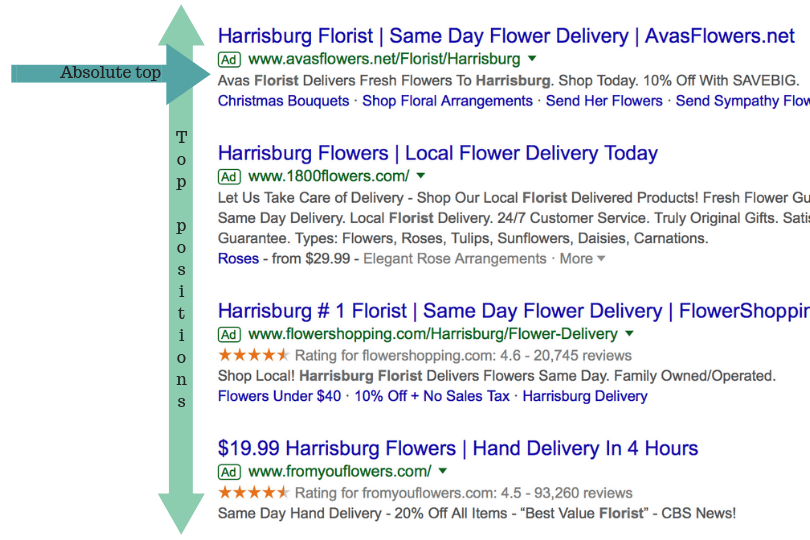What Are the Most Important KPIs for Google Ads?
While it’s always better to have too much information than too little, it’s best to have the right information. That means determining the right KPIs for your site, finding them in Google Ads, and using them to make your PPC campaigns better.
The best metrics may vary from one campaign to another, but these Google Ads KPIs are some of the most useful to achieve success.
1. Impressions
Successful ads have to start by showing up for people in your target audience. Every time your ad displays, it’s called an “impression.”
The impressions metric isn’t necessarily an indication of how well your ad is performing, but it shows you how many people actually see it. And you can’t have a successful ad if nobody sees it in the first place, so you need to watch the number of impressions you get per day, week, or month.
2. Click-through rate
After someone sees your ad, they have an opportunity to click on it. Every time they do, it counts as a click. And every time they don’t, it doesn’t count toward anything.
The percentage of people who click your ads to go to your site is called the “click-through rate” (CTR). These are the people that your ad engaged, and a high CTR is an indication that your ad is performing exceptionally well.
As you measure CTR, you may discover one search term outperforming another, or a call to action that’s particularly powerful. Look at the ads that get the best CTR to determine how you can refine your whole strategy for more clicks.
3. Conversion rate
When someone clicks on your ad, they go to a landing page that encourages them to take a specific action that’ll help them become a paying customer.
The people who follow through with that action contribute to your conversion rate, which is a measurement of how many people click on your ads and then become customers.
This KPI will also give you an idea about how good your Google Ads return on investment (ROI) is. The better your conversion rate, the more money you’re making.
4. Cost per conversion
PPC advertising is unique because of how much control you have over the cost of advertising. You can always adjust your bids for every keyword depending on how much you’d like to spend.
Cost per conversion shows you the average amount of money you spend on PPC for every conversion that you earn. Ideally, this cost will be as low as possible. But not everyone converts after they click your ad, so it’s possible that this cost could be high.
Still, the payoff you get from an average conversion should be more than enough to cover the cost. And if it isn’t, you need to make some big changes to your PPC campaigns.
5. Average position
Average position is an indication of where your ads usually fall when they’re triggered. So if you have an average position of 7.5, you most often show up toward the bottom of ad listings. If you have an average of 3.2, you usually show up at the top.
Your ad needs to place eighth or higher to get on the first page of ad results. Naturally, the ad that’s listed first has the best chance of getting the most clicks, but that doesn’t mean your campaign is bad if you show up lower than that.
In fact, you can still get enough traffic and conversions to justify your PPC campaign if your average position is seventh or eighth — you just won’t get as much traffic as first or second.
6. Quality score
Quality score is an expression of how reliable your company is in showing people relevant information. So if someone looks up “running shoes,” then clicks your ad, but they go to a page about dress shoes, your quality score won’t be high.
However, if someone looks up “running shoes,” then clicks on your ad, and they go to a page that sells sneakers, your quality score will be much higher — and you’ll probably get a new customer!
When your quality score is high, Google Ads will actually give you a discount on your ad costs since you’ve proven that you’re a reliable source of information for Google users. That means your cost per conversion goes down, and your ROI goes up.
But when your quality score is low, you’ll actually pay more to maintain the same ad positioning for keywords. That’s why it’s important to learn how to improve your Google Ads quality score.
Quality score is based on a scale of one to 10, and Google considers five to be average.
If your quality score is a perfect 10, you get a 50% discount on keywords compared to what you spend with a quality score of five.
On the flip side, if your quality score is a one, you pay 400% more because you’ve shown Google that you’re a poor source.
With that in mind, it’s critical to pay attention to your quality score — especially if you want to save money on your PPC campaigns.
8 other Google Ads KPIs to know
- Impression (absolute top) percentage: This is the percent of impressions for a given ad that appears first above the organic search results. With this percentage, you will see how often your ad appears as the first ad in the search results. It calculates how many people see your ad as the top results, rather than the number of people that click on it.
- Impression (top) percentage: This is the percent of impressions for your ad that are shown at any point above the organic search results. Whether it’s the first position or the third position, this will count towards this percentage.
- Search (absolute top) impression share: With this impression share (IS) metric, you focus on the number of impressions you’ve received in the very top ad position compared to the number of impressions you could have received in that position. This boils down to the number of people that see your ad divided by the number of people who could have seen it.
- Search (top) impression share: This is the number of impressions you receive in a top location (can be any of the top ad positions) compared to the number of impressions you could receive from an ad.
- Search lost top IS (budget): This is the number of missed top impressions due to budget restraints. With this metric, you see how many impressions you missed in any top position because you don’t have a big enough budget to obtain more. It’s helpful for you to see what would happen if you expanded your budget.
- Search lost top IS (rank): This is the number of missed impressions in any top ranking spot due to your Ad Rank. You can see how many impressions you miss because of your ad’s position. This helps you understand how your ad can perform differently in select positions.
- Search lost absolute top IS (budget): With this number, you’ll see the number of missed absolute top (first position) impressions due to your budget. This number helps you see how many top spot impressions you miss because of budget issues or restraints.
- Search lost absolute top IS (rank): This metric helps you see how many impressions you miss due to your Ad Rank. It’s especially helpful if you have the first ad position, but your ad appears as the first ad at the bottom.

How do these Google Ads metrics help advertisers?
Here are three reasons why you’ll want to pay attention to these metrics.
1. You get better insight into your campaign
These metrics help you understand your campaign’s performance. They are extremely beneficial for helping you understand your average position better. You’ll have a more accurate understanding of your ad’s true average position and how it affects your campaign.
Impressions are a big part of running pay-per-click (PPC) ads. When you know how the different impressions affect how many people see your ad versus the number of people that click on, you can better optimize your campaign.
2. You see how well your ads perform on mobile
These metrics help you see how your ads perform on mobile. You’ll see how often your ads appear at the top. This is important to note because 52 percent of PPC clicks come from mobile users.
This is backed by the fact that 46 percent of people can’t tell the difference between PPC ads and organic search results, especially on mobile. Mobile users are more likely to click on the ads because they’re looking for answers fast and the first result seems the most relevant.
When you can monitor your ad position more accurately, you’ll have a better understanding of how you perform on mobile.
3. You can improve your ads
More insight into your campaign means more opportunities to make it better. When you have more accurate metrics to help you monitor your ad’s performance, you have more opportunities to improve your campaign.
These metrics help you see how your ad is performing in different positions. You can see how a number two position at the top of the results and number two position at the bottom of the results will impact your campaign. This information will help you understand how you can improve your campaign to drive better results.
This can be something as simple as changing your ad copy to make it more relevant. More relevant ad copy leads to a better quality score, which is one of the determining factors for your ad position. This leads to a better ad position, which leads to more positive results for your campaign.
These new metrics will help you measure your campaign more accurately, so you can drive more positive results and reach more leads with your Google Ads.
WebFX knows KPIs and PPC
At WebFX, we have a full team of PPC experts who have worked in the industry for years. They know how to help companies grow, especially over long periods of time. With your investment in good hands, we’ll check critical KPIs as often as possible to make sure your PPC campaign brings you more customers — and revenue.
Contact us today to set up a PPC strategy that’ll help grow your company!
Related Resources
- Marketing KPIS
- Marketing or Advertising: Which Will Attract More Customers?
- Marketing Techniques
- Marketing vs. Advertising
- Multivariate Testing Vs AB Testing
- Online Marketing Strategies
- Online Recruitment Marketing
- Online Reputation Management Guide
- Online Revenue Models
- PPC Metrics: 5 Key Paid Search Metrics to Watch
Marketing Tips for Niche Industries
- How to Get LegitScript Certified: a Step-By-Step Guide for Rehab Centers
- How to Use PPC for Insurance Agencies
- LegitScript Certification for Treatment Centers on Facebook
- LegitScript for Google Ads
- Orthodontist PPC: Pay-Per-Click for Orthodontists
- Paid Search for Physicians: Everything Doctors Need to Know
- Pay-Per-Click Advertising (PPC) for Cabinet Manufacturers: How to Get Started
- PPC Advertising for Consulting Businesses
- PPC Agency for Fire Protection Companies
- PPC for Architecture Firms: Capture More Revenue with Architect PPC










